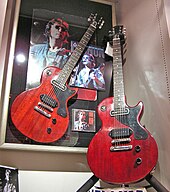Musicianship
Instruments played
Further information: John Lennon's musical instruments and List of the Beatles' instruments
Lennon's playing of a mouth organ during a bus journey to visit his cousin in Scotland caught the driver's ear. Impressed, the driver told Lennon of a harmonica he could have if he came to Edinburgh the following day, where one had been stored in the bus depot since a passenger left it on a bus.[232] The professional instrument quickly replaced Lennon's toy. He would continue to play harmonica, often using the instrument during the Beatles' Hamburg years, and it became a signature sound in the group's early recordings. His mother taught him how to play the banjo, later buying him an acoustic guitar. At 16, he played rhythm guitar with the Quarrymen.[233] As his career progressed, he played a variety of electric guitars, predominantly the Rickenbacker 325, Epiphone Casino and Gibson J-160E, and, from the start of his solo career, the Gibson Les Paul Junior.[234][235] Double Fantasy producer Jack Douglas claimed that since his Beatle days Lennon habitually tuned his D-string slightly flat, so his Aunt Mimi could tell which guitar was his on recordings.[236] Occasionally he played a six-string bass guitar, the Fender Bass VI, providing bass on some Beatles numbers ("Back in the U.S.S.R.", "The Long and Winding Road", "Helter Skelter") that occupied McCartney with another instrument.[237] His other instrument of choice was the piano, on which he composed many songs, including "Imagine", described as his best-known solo work.[238] His jamming on a piano with McCartney in 1963 led to the creation of the Beatles' first US number one, "I Want to Hold Your Hand".[239] In 1964, he became one of the first British musicians to acquire aMellotron keyboard, though it was not heard on a Beatles recording until "Strawberry Fields Forever" in 1967.[240]
Vocal style
When the Beatles recorded "Twist and Shout", the final track during the mammoth one-day session that produced the band's 1963 debut album, Please Please Me, Lennon's voice, already compromised by a cold, came close to giving out. Lennon said, "I couldn't sing the damn thing, I was just screaming."[241] In the words of biographer Barry Miles, "Lennon simply shredded his vocal cords in the interests of rock 'n' roll."[242] The Beatles' producer, George Martin, tells how Lennon "had an inborn dislike of his own voice which I could never understand. He was always saying to me: 'DO something with my voice! ... put something on it ... Make it different.'"[243] Martin obliged, often using double-tracking and other techniques. Music critic Robert Christgau says that Lennon's "greatest vocal performance ... from scream to whine, is modulated electronically ... echoed, filtered, and double tracked."[244]
As his Beatles era segued into his solo career, his singing voice found a widening range of expression. Biographer Chris Gregory writes of Lennon "tentatively beginning to expose his insecurities in a number of acoustic-led 'confessional' ballads, so beginning the process of 'public therapy' that will eventually culminate in the primal screams of "Cold Turkey" and the cathartic John Lennon/Plastic Ono Band."[245] David Stuart Ryan notes Lennon's vocal delivery to range from "extreme vulnerability, sensitivity and even naivety" to a hard "rasping" style.[246] Wiener too describes contrasts, saying the singer's voice can be "at first subdued; soon it almost cracks with despair".[247] Music historian Ben Urish recalls hearing the Beatles' Ed Sullivan Show performance of "This Boy" played on the radio a few days after Lennon's murder: "As Lennon's vocals reached their peak ... it hurt too much to hear him scream with such anguish and emotion. But it was my emotions I heard in his voice. Just like I always had."[248]

No comments:
Post a Comment